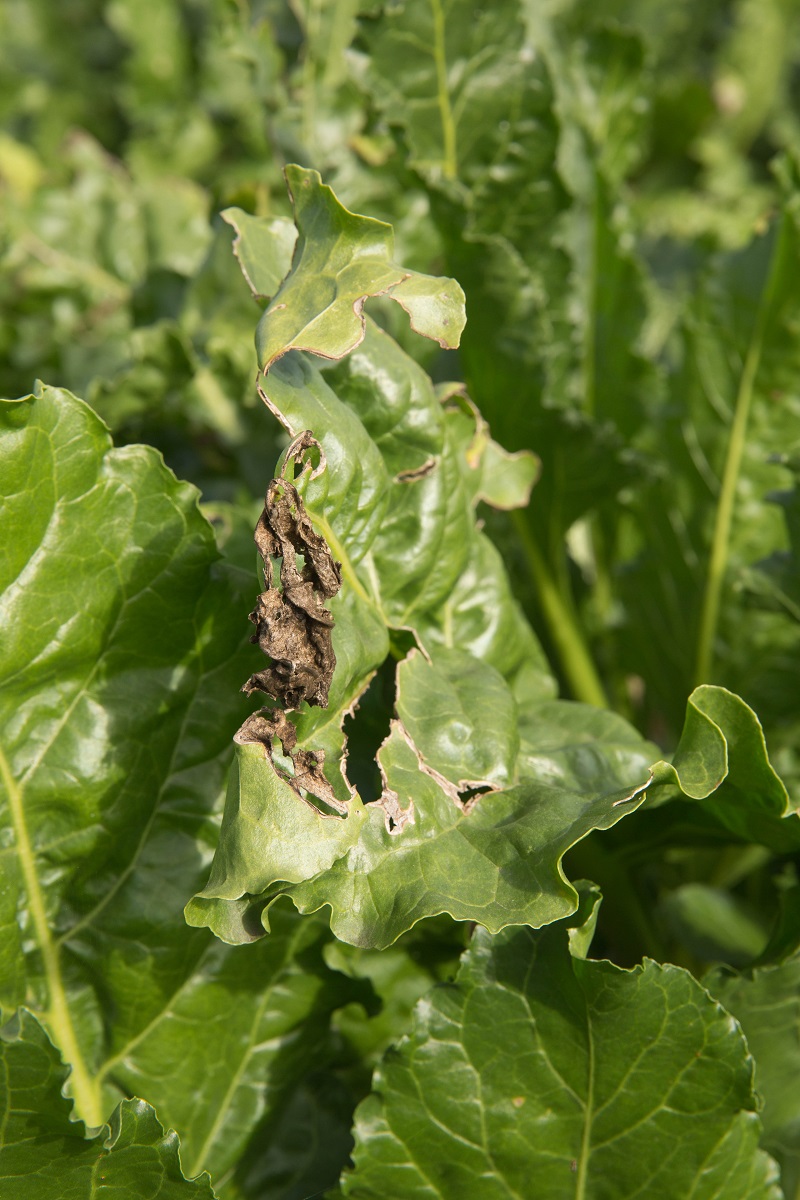
March heralds the start of sugar beet drilling. It seems the winter weather may create its fair share of challenges to growers right from the word go. CPM finds out what to be ready for this spring.
The current mild winter is ensuring a green bridge for disease development.
By Lucy de la Pasture
Times are a changing in sugar beet agronomy. Where weed control used to be the agronomist’s nemesis, more difficult challenges have risen to the fore and the solutions aren’t necessarily found in a pesticide can. And then there’s the effects of the season to factor in…
There’s nothing like a really cold snap to snuff out overwintering populations of pests and diseases. And so far there’s been nothing like a cold snap this winter. Although Feb has had a frost or two, at times the winter has been positively balmly. Both broadleaf and grassweeds have continued to grow so there’s a real risk that the green bridge could create early pest and disease pressure this spring.
Getting rid of the green bridge is of paramount importance and will help with the cultural control of a number of problems, says independent sugar beet specialist, Dr Pat Turnbull. One of those is downy mildew – not a new disease in sugar beet but one that has been rising in significance over recent years on some soil types, particularly chalky soils in South Cambs, South Lincs and West Norfolk.
Downy mildew
“We had hoped that the shorter campaign would help limit downy mildew but the disease will likely have

Downy mildew will likely have overwintered well.
overwintered well. Clamp hygiene is an important measure because beet downy mildew can overwinter on crop residues and it’s essential to control any volunteer beet, which can act as a reservoir of inoculum for the disease,” she says.
Dr Mark Stevens, lead scientist at BBRO, agrees saying, “The current mild winter is ensuring a green bridge for disease development in spring 2016 and on-farm hygiene and cultural control is critical to prevent further build-up and spread.”
Although generally a localised problem, where downy mildew does pop up there are no fungicides registered for use in the crop to control it. With yield losses of up to 30% from 40% downy mildew infection, there are serious financial implications where the disease occurs. Mark Stevens believes that downy mildew may be on the increase because varieties have lost minor gene resistance to the problem.
“We’ve noticed marked differences between the seed houses in the susceptibility of their varieties to downy mildew. From six trials assessed in 2014/15, there appeared to be varietal resistance to the disease with most of these varieties from KWS and Limagrain. This observation has been supported by evidence from the BBRO plant clinic as well as similar findings in Europe,” he adds.
“BBRO are looking at possible fungicides with activity on downy mildew but harnessing the genetic resistance of the seed houses is likely to provide the biggest step forward.”
A more widespread challenge this spring is likely to come from pests – with aphids, nematodes and beet miner topping the list of potential issues. The ban on use of the neonicotinoids (neonics) in oilseed rape may be another factor contributing to aphid numbers surviving the winter as well as the markedly warmer than normal winter.

Harnessing the genetic resistance of varieties is likely to provide the biggest step forward for downy mildew control, reckons Mark Stevens.
Mark Stevens reckons the fact that Rothamsted recorded a winged carrot-willow aphid in their suction traps during Feb may not bode well because it’s about ten weeks earlier than last year. Rothamsted Research scientist, Mark Taylor, is responsible for identifying aphids caught in suction traps as part of the Insect Survey.
“It’s a little early to look forward to the new season with any degree of certainty but the best predictor is the mean temperature in Jan and Feb,” he explains.
“Confidence is greatest for those aphid species which pass the winter in the active stages rather than as eggs, which includes the peach–potato aphid (Myzus persicae).”
Aphid numbers
In England the mean temperature for Jan was 1.1°C above the long term average, following a Dec which witnessed temperatures more akin to April and May and 4.1°C above average. So what’s the likely impact on aphid numbers for next season?
“Although there’s still time for a significant cold snap to affect our forecast, it’s looking like a year on the early side of average for first flights and on the higher side of average for spring/early summer numbers of M. persicae,” believes Mark Taylor.
With 99% of growers using seed treatments that give up to 14 weeks’ protection against aphids, is there any reason for concern?
“In a normal season, the neonic seed treatments will have provided the crop with a high degree of protection against virus yellows. If there’s high aphid pressure early in the season, then we could potentially get primary infection,” says Mark Stevens.
- persicae need to feed for plants to acquire virus yellows and usually less than 1% of the aphid population actually carry the virus so early numbers need to be high for primary infection to be significant.
“Sugar beet seed treated with first generation neonic, imadacloprid (Nuprid 600 FS), offers up to ten weeks’ protection. The second generation neonics found in Cruiser Force (thiamethoxam+ tefluthrin) and Poncho Beta (clothianidin+ beta-cyfluthrin) have longer persistence.”
Pat Turnbull says there’s precious little in the armoury to control M. persicae when the seed treatments have run out or numbers are so high primary infection is a worry.
“At the moment, we’re totally reliant on seed treatments for M. persicae control because the extent of both MACE and Kdr resistance means that pirimicarb and pyrethroids are no longer effective,” she explains.
Coded products
Finding an aphicide that’ll control M. persicae is something that BBRO are actively investigating. “We looked at a range of insecticides, including coded products, and have found Teppeki (flonicamid) had useful activity but is currently only approved for use in potatoes and winter wheat,” explains Mark Stevens.
“We’re hopeful that the label may be extended to include sugar beet which would give growers an option and we have to be mindful of the future and the pressure that the neonics are under.”
Simon Leak of Belchim confirms the expected label change. “We’re expecting an on-label approval for Teppeki in sugar beet in time for the coming season, subject to CRD approval,” he says.
“Teppeki is effective against all forms of aphids that are resistant to other chemical groups such as MACE, which confers resistance to pirmicarb, and super Kdr which confers resistance to pyrethroids.”
With an eye to the future, BBRO are developing a pre-breeding strategy to reduce the reliance on insecticides for virus yellows control by identifying genes for resistance and tolerance against the virus yellows complex.
With Vydate (oxamyl) missing from the market place in 2016, free-living nematodes (FLN) are another problem facing growers where there’s no chemical control available. Where FLN are a problem and switching fields in the rotation hasn’t been an option, the best growers can hope for is a dry spring, reckons Mark Stevens.
“If the water table is low, then beet plants are normally able to grow without any significant direct feeding damage. The flip side is that if fields are wet and the water table is high, which is more how the season is looking, then nematodes are higher up in the soil profile and closer to the emerging roots where they can feed.”
Although other nematicides are being evaluated for use in the beet crop, in the short term there’s nothing else growers can use. “The problem is we’re completely reliant on nematicides for FLN control but we need to be looking at alternative approaches, such as genetics to evaluate genes for FLN tolerance and cultural methods including biofumegant cover crops,” he suggests.
So practically what can growers do where FLN may be a problem? Getting crops quickly up and away is the best bet, believes Pat Turnbull. “Where I have fields susceptible to docking disorder, they tend to have muck as well as early N. The increase in organic matter content and nutritional benefits help push early leaf growth,” she says.
The other pest of concern and one that gave growers a few headaches last season is leaf beet miner – larvae of the mangold fly. Dr Sacha White of ADAS has been leading a BBRO leaf miner project to assess the pest more closely and evaluate options for control.
“The mining and blistering damage caused by leaf miner reduces the green area of the crop and can cause additional problems with frost damage, herbicide susceptibility and disruption to harvest schedules,” he explains. “Because the leaf miner burrows into leaves, it’s an elusive target and there are few options for control.”
One of those options is Hallmark Zeon (lambda-cyhalothrin) and questions have been expressed concerning its effectiveness on leaf miner in the field. “We suspected part of the problem was because there’s a very narrow window to apply the pyrethroid to actually make contact with the larvae,” explains Sacha White. “We also weren’t sure whether generations were overlapping which would make targeting sprays even more difficult.”
The first generation of leaf miner is pretty well controlled by the neonic seed treatments, usually during April or May. The second generation tends to occur around the time when seed treatments are running out of steam so crops are sometime protected, sometimes not. The third generation usually occurs in Aug onwards when a foliar insecticide is definitely the only option for control.
“We looked at ten insecticides in trials and both Hallmark Zeon and Danadim Progress (dimethoate) gave reasonable levels of control, with some of the coded products also looking promising. Control was best when insecticides were applied at egg hatch and egg laying,” explains Sacha White. “Timing could be improved and better targeting could also improve the control efficacy of other treatments.”
Part of the project involved looking more closely at the pest to identify emergence patterns, male and female populations, identify any regional differences and relate to local pest pressures as a first step towards improving spray targeting.
“The data from the project shows that there appears to be a distinct gap between generations, which is good news. There’s scope to go on to develop systems to predict egg hatch which will allow better targeting of the pest,” he says.
At the moment it looks like there’s potential for an interesting growing season with still more questions than answers. “But on the plus side, if the season is one that favours pests then there’ll also be a high number of beneficial insects to help us out,” reminds Mark Stevens.
Herbicide-tolerant sugar beet enters RL trials
Two sugar beet varieties with a natural tolerance to a highly effective herbicide that cannot otherwise be used in the crop have been entered into official RL trials in the UK. The new varieties will expand the weed-control options available to growers while also making it easier. The varieties could be commercially available to growers in time for the 2019-20 season, approval permitting.
Bred by KWS using standard breeding techniques, the varieties feature a natural tolerance to herbicides of the acetolactate synthase (ALS) inhibitor class. The technology will be branded Conviso Smart.
“Conviso sugar beet will mean growers can control a wide range of weeds, including many otherwise hard to tackle species, with greater ease and without risking crop safety or yield potential,” says Simon Witheford, KWS sugar beet product manager.
“It’s the result of many years of research and development that will benefit growers in much the same way as previous advances, such as Rhizomania and nematode resistance. It’s exciting that we can provide a non-GMO solution to weed control in sugar beet,” he adds.
The tolerance to ALS inhibitor herbicides is the result of a natural variation in the gene encoding the ALS enzyme. Once identified, this was then back-crossed into elite hybrid plants to produce high yielding varieties suited to commercial cultivation. It wasn’t forced by mutagens or mutagenic conditions and is not the result of GM breeding techniques.
Plants carrying this variation are tolerant to a specific ALS-inhibiting herbicide developed by Bayer. “The herbicide has performed exceptionally in trials, demonstrating reliable control of a wide range of broadleaved and grass weeds and effective control of weed beet populations,” says Edward Hagues of Bayer.
“In addition, the new herbicide offers greater flexibility in application timing compared with standard herbicides and requires fewer passes to achieve control,” he adds.
An application supporting the herbicide’s registration in sugar beet is currently being evaluated by regulators. For the technology to be available to UK growers, both the herbicide and varieties will need to gain registration through their respective regulatory bodies.
Consider application systems when looking at herbicide costs
With sugar beet prices down on last year there’s increased pressure on growers to maintain margins by reducing input costs, with herbicide inputs increasingly under the spot light.
But one thing growers can’t compromise is their weed control because the effect weed competition has on yield in the sugar beet crop, says Norfolk-based AICC agronomist Mike Thompson of N W Agronomy.
“Poor weed control can typically reduce yields by 35%, with taller weeds such as volunteer beet, redshank, fat hen and pale persicaria all competing for light, nutrients and water,” he says.
Most growers are aiming for yields of 70t/ha to make the crop viable, so there’s not much scope to scrimp on herbicides but there is flexibility when it comes to application strategies.
In a typical season, Mike Thompson employs a range of strategies for sugar beet weed control to suit each farm enterprise. His conventional programme is based on a pre-emergence followed by up to three post-emergence sprays, but he also uses the FAR approach, up to six low-dose applications and Broadacre, which involves two post-emergence applications of contact material plus a residual element.
“Being committed to growing sugar beet means maximising yields. The Broadacre approach adds flexibility and especially suits growers where later weed emergence isn’t a problem or blocks of beet are some distance away from the base,” he says.
“Broadacre can follow a pre-em application and is applied later than a conventional programme with the first post-em timed at the first two true leaf timing (mid May) of the crop, and is followed by a second application of the same tank mix two weeks later.”
A typical Broadacre tank-mix would be phenmedipham at 2.5l/ha plus ethofumesate at 0.4l/ha plus Debut (triflusulfuron-methyl) at 20g/ha plus Venzar FL (lenacil) at 0.4l/ha plus Goltix (metamitron) at 0.5l/ha and oil.
“This mix tackles all the key problem weeds often found on mineral and fen soils, including cleavers, thistle, mayweed, volunteer oilseed rape, fool’s parsley, knotgrass, chick weed, fat hen, redshank and pale persicaria,” says Mike Thompson.
“Broadacre offers a flexible approach to weed control and ensures a wider operating window, which means the beet can be left to grow larger before spraying. That’s a plus because in other approaches you’re hitting a little weed and that means also hitting a tiny beet which is more susceptible to herbicide damage when small.”
Even though the beet has two leaves when sprayed using this system, Mike Thompson says growers still need take care when spraying crops. He points out that the speed of weed growth and relative humidity will affect herbicide efficacy but with just two Broadacre applications, conditions must be right.
“It’s an ideal option for taking out larger weeds, so where weeds might have been missed from a previous application or a pre-emergence herbicide was not applied,” he says.
“Switching to the Broadacre approach requires confidence and trust but, where I have used it, robust weed control, timing flexibility and cost effectiveness have been clear benefits.”

Downy mildew will likely have overwintered well.




